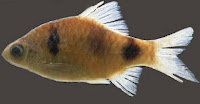The endemic aquatic fauna of southern Western Ghats has got one more member recently, when researchers have identified a new barb belonging to the Puntius family of fishes from the streams in Kerala and Tamil Nadu. Christened as Puntius nigripinnis Sp., this new fish was identified from the streams of TamilNadu and Kerala.
 |
| Adult male Puntius nigripinnis sp. collected from Kalindi river in Wayanad in Kerala, India (collected by Rahul G. Kumar) |
P. nigripinnis now adds to the more than a dozen variants of the widely distributed barb Puntius ticto. The major morphological difference P. nigripinnis has with other members of the P. ticto complex is the absence of barbels along with the presence of the last unbranched dorsal ray serrated.
This dark brown fish has a black band which forms a ring around the caudal fins. Being identified for the first time, it is now known to exist only from Moyar River range in Nilgiris and Kalaindi stream in Wayanad district of Kerala, both streams originating from the southern Western Ghats.
Location of the body spots are one major feature which makes the newly identified fish different from the similar looking close relatives. The humeral spot on this fish is on the 3rd and 4th scale of the lateral line while it is on the 4th and 5th scale below the lateral line for its close relatives like P. punctatus and P. muvattupuzhaensis.
 |
| Puntius nigripinnis sp. |
Again the black ring is a distinguisher for P. nigripinnis. The large spot which is located on the 18th and 19th scales on the caudal peduncle which forms a band is not prominent in other members of the P. ticto complex. They exist as different spots in P. ticto, P. stoliczkanus, P. manipurensis, and P. pookodensis, making them visually different from P. nigripinnins.
According to a research paper published in the Journal OF Threatened Taxa, researchers and naturalists from Zoological Survey of India and Manonmaniam Sundaranar University has named the fish based on these properties, by coupling the Latin words ‘niger’ which means black and ‘pina’ which means fin. J D Marcus Knight, K Rema Devi, T J Indra and M Arunachalam conducted the study.
 |
Currently known distribution of Puntius nigripinnis sp. nov. A - Kalindi stream in Wyanad (~ 11047’N & 7604’E); B - Kakkan Halla, Moyar River (~11034’N & 76049’E).
|
The new finding also indicates the richness of unexplored flora of Western Ghats and the importance to conserve it. Though conservation of terrestrial fauna has got popular acceptance, aquatic fauna is still under threat from indiscriminate fishing. Use of pesticides and agro chemicals in the upper stream fields of the Western Ghats Rivers also threaten endemic species like P. nigripinnis.
Other members of the Puntius ticto complex.
 |
| P. punctatus |
 |
| Puntius ticto |
 |
| P. muvattupuzhaensis |
 |
| P. phutunio |
 |
| P. pookodensis |
 |
| P. setnai |

Western Ghats is a real biodiversity hot spot. hope such discoveries will bring more attention to conservation activities here.
ReplyDelete